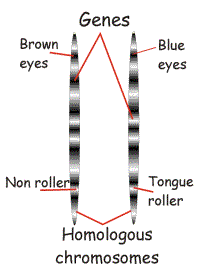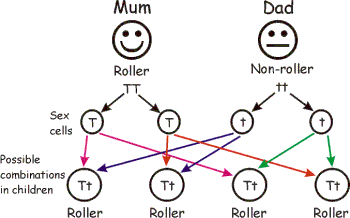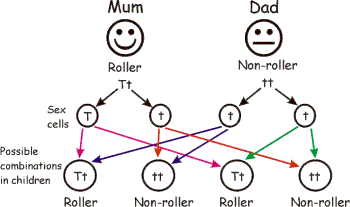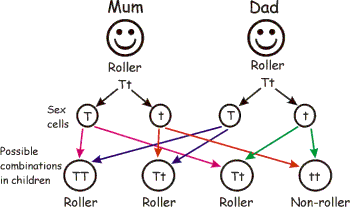Genetics and Inheritance 2
Humans have a diploid number of 46 (46 chromosomes). Our chromosomes come in pairs called homologous pairs. Each chromosome has similar genes in similar places, though the variety of each gene may be different. The variety of gene is known as an allele. We get one chromosome in the pair from each parent, so we inherit 23 chromosomes from each parent.

Looking at the homologous chromosome pair above you can see that the gene for eye colour is in the same position in both chromosomes but there are two alleles. There gene for brown eyes (the brown eye allele) is one variety while the blue eyes allele is a different variation of the eye colour gene. The same goes for tongue rolling.
If a child inherits two genes for blue eyes, one from each parent, then they only have the instructions to make blue eyes. Therefore the child will have blue eyes. The same is true if the child has two genes for brown eyes, the child must have brown eyes. What will happen if a child inherits a blue eye allele from one parent and a brown eye allele from the other? Which gene is used?
The cells have to make a choice as to which gene they use. Genes come in two varieties.
- Dominant - this is the strong gene. There only needs to be one copy of the dominant gene for it to show its characteristic.
- Recessive - this gene is weak. It will not show its characteristic if there is a dominant gene present. It will only work when there are two recessive genes present.
Here is a list of some common dominant and recessive genes.
| Dominant | Recessive |
|---|---|
| Tongue rolling Black hair Woolly hair Blood group A and B Brown eyes |
Non roller Blonde hair Straight hair Blood group O Blue eyes |
So, if a child had both a brown eye gene and a blue eyed gene they would have brown eyes. The actual genes the person possesses is know as the genotype while their actual characteristics is known as the phenotype. They could be said to be a carrier of the blue eyes gene as it is possible for them to pass it on to their offspring even though it does not have an effect in themselves. If the blue eyes gene paired up with another blue eyes gene in future generations then the blue eye characteristic will become visible.
Below are some examples of inheritance. We will use tongue rolling to illustrate the points, but the principle is the same for each characteristic chosen.
The letter T will be used to designate a tongue roller (dominant) while the letter t will be used to designate a non-roller (recessive).
If a person's genotype was TT then they are said to be homozygous dominant (homo meaning the same). If their genotype was tt then they are said to be homozygous recessive. If their genotype was Tt then they are said to be heterozygous (hetero meaning opposite).
If a tongue roller (TT) had a child with a non-roller then the possible outcomes can be illustrated in a diagram as shown below.

As is shown above, all possible outcomes result in a heterozygous tongue roller. The picture would be very different is the tongue rolling parent had been heterozygous (Tt). This can be shown below.

As you can see now, there is a 50% chance of getting either a roller or a non-roller child. Remember, the diagrams only show the possible combinations. If the parents above had 4 children, there is a 50% chance for each one that they will be a roller or non-roller. It is possible for them to have four non-roller children or four roller children or indeed any combination.
If two heterozygous parents have children then the possible outcomes are shown below.

Here we have a 25% chance that a non-roller is born. This example shows how a recessive trait, hidden in the parents, can become visible in their offspring.
